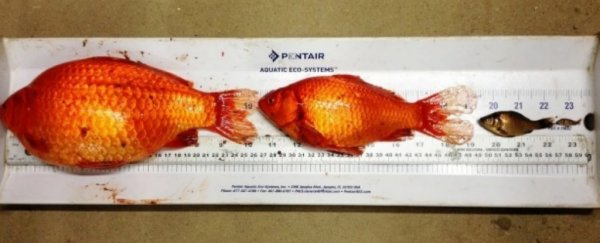Goldfish (Carassius auratus) are cute and low-maintenance pets, but research has shown that when they end up in lakes and rivers, they can grow up to 10 times their original size and travel long distances, making them an incredibly invasive pest.
A team of Australian researchers has reported finding wild goldfish that weigh up to 1.9 kg (4 pounds), and they're wreaking havoc on the local ecosystem.
The researchers are studying the Vasse River in southwest Australia, which had goldfish introduced into it more than two decades ago, and has seen the population surge over the past 12 years. The most likely cause of the infestation was pet owners.
"Perhaps they were kids' pets where the family have been moving house and their parents, not wanting to take the aquarium, have dumped them in the local wetlands," lead researcher Stephen Beatty from Murdoch University in Perth, told ABC News.
"Unfortunately a lot of people don't understand that wetlands connect up to river systems and introduced fish, once they get in there, can do a lot of damage to native freshwater fish and the aquatic habitat."
In their latest study, the team tagged 15 wild goldfish in the Vasse River near the Western Australian city of Busselton, and tracked their movements for 12 months.
They showed that the species could move much further than originally suspected, heading to a wetland system to spawn throughout the year.
"Our research discovered the fish displayed a significant seasonal shift in habitats during breeding season, with one fish moving over 230 kilometres during the year," said Beatty.
So what's so bad about these over-sized goldfish?
Not only do the fish, which are native to eastern Asia, grow as large as resources will allow - which in this case, is pretty big - they're also carnivorous.
"They cruise along the bottom stirring up the substrate with their feeding strategy, this can re-suspend nutrients into the water column which exacerbates things like algal blooms," said Beatty. "They can also disrupt aquatic plants and eat other fish's eggs."
The team also suspects that goldfish have introduced at least one disease to the region already, and are responsible for a decline in native freshwater fish species.
And Australia isn't the only country to see this problem. Last year, Colorado Parks and Wildlife officials reported an infestation of around 4,000 goldfish in a lake in Boulder Country, after someone dumped a handful of pet goldfish into a nearby waterway.
Lake Tahoe in California has also been infested.
And Canadian authorities last year put out a plea to stop pet owners from dumping their goldfish, saying that the species is now taking over many lakes and ponds, and pushing out native species.
But now that they know how the species is migrating - in Australia, at least - Beatty and his team will use the information to come up with strategies to try to stop the species and remove them from Vasse River.
In the meantime, people really, really need to stop dumping their pet goldfish - they look cute, but those things can grow up to become monsters.
The research has been published in the Ecology of Freshwater Fish.
